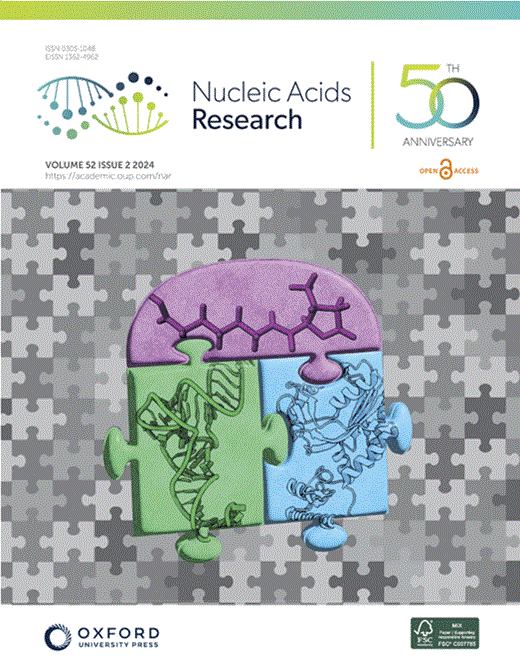靶向SARS-CoV-2 RNA g -四联体金属螺旋的筛选
IF 16.6
2区 生物学
Q1 BIOCHEMISTRY & MOLECULAR BIOLOGY
引用次数: 0
摘要
许多SARS-CoV-2变种的出现,降低了疫苗和药物的效力,仍然是抗击这一疾病的主要挑战。SARS-CoV-2基因组中的RNA g -四联体(G4s)高度保守,因此被认为是对抗更广泛变异的有希望的治疗靶点。然而,报道的RNA G4特异性化合物很少。本文构建了一个包含64种手性金属螺旋的小文库,用于筛选SARS-CoV-2 g4特异性结合物。经过筛选,我们发现其中一对对映体具有最佳的对映选择性。Λ对映体在Vero E6细胞中具有较强的稳定SARS-CoV-2 G4s、抑制病毒蛋白表达、降低SARS-CoV-2 RNA拷贝数和病毒滴度的作用。而在相同的实验条件下,Δ对映体的作用远弱于Λ对映体,表现出明显的对映选择性。进一步研究表明,Λ对映体更倾向于与SARS-CoV-2 G4s结合,而不是与单双链DNA和常见的人类DNA G4s结合,表明其对RNA G4s具有选择性。该研究为SARS-CoV-2 G4s的对体选择性靶向提供了第一个例子,并将促进针对病毒G4s的候选药物的开发。本文章由计算机程序翻译,如有差异,请以英文原文为准。
Screening of metallohelices for enantioselective targeting SARS-CoV-2 RNA G-quadruplex
The emergence of numerous variants of SARS-CoV-2 still presents the major challenges in the fight against this disease by reducing the efficacy of vaccines and drugs. RNA G-quadruplexes (G4s) in the SARS-CoV-2 genome are highly conserved and have thus been spotlighted as a promising therapeutic target to combat a wider range of variants. However, very few RNA G4 specific compounds have been reported. Here, a small library of 64 chiral metallohelices has been constructed for screening SARS-CoV-2 G4-specific binders. After screening, we found that one pair of the enantiomers showed the best enantioselectivity. The Λ enantiomer can strongly stabilize SARS-CoV-2 G4s, inhibit the expression of virus protein, and reduce the SARS-CoV-2 RNA copies and viral titers in Vero E6 cells. In contrast, the Δ enantiomer has much weaker effects than the Λ enantiomer under the same experimental conditions, showing an obvious enantioselectivity. Further studies indicate that the Λ enantiomer prefers binding to SARS-CoV-2 G4s rather than binding to the single/double-stranded DNA and commonly reported human DNA G4s, indicating its selectivity to RNA G4s. This work provides the first example for enantioselectively targeting SARS-CoV-2 G4s, and will promote developing drug candidates for targeting virus G4s.
求助全文
通过发布文献求助,成功后即可免费获取论文全文。
去求助
来源期刊

Nucleic Acids Research
生物-生化与分子生物学
CiteScore
27.10
自引率
4.70%
发文量
1057
审稿时长
2 months
期刊介绍:
Nucleic Acids Research (NAR) is a scientific journal that publishes research on various aspects of nucleic acids and proteins involved in nucleic acid metabolism and interactions. It covers areas such as chemistry and synthetic biology, computational biology, gene regulation, chromatin and epigenetics, genome integrity, repair and replication, genomics, molecular biology, nucleic acid enzymes, RNA, and structural biology. The journal also includes a Survey and Summary section for brief reviews. Additionally, each year, the first issue is dedicated to biological databases, and an issue in July focuses on web-based software resources for the biological community. Nucleic Acids Research is indexed by several services including Abstracts on Hygiene and Communicable Diseases, Animal Breeding Abstracts, Agricultural Engineering Abstracts, Agbiotech News and Information, BIOSIS Previews, CAB Abstracts, and EMBASE.
 求助内容:
求助内容: 应助结果提醒方式:
应助结果提醒方式:


